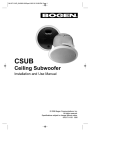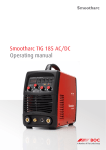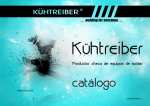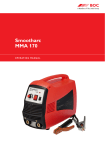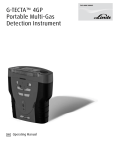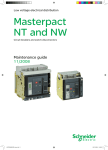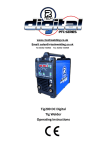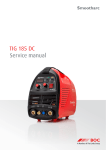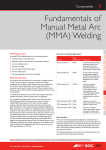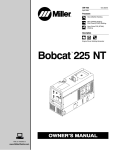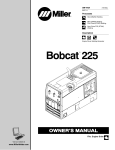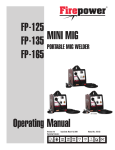Download R-Tech I-MIG200 Specifications
Transcript
MIG 200C/275C/275R/350R Operating manual 2 BOC Smootharc Advance MIG 200C/275C/275R/350R Operating manual Welcome to a better way of welding. This operating manual provides the basic knowledge required for MIG Welding, as well as highlighting important areas of how to operate the Smootharc ADVANCE machines. With normal use and by following these recommended steps, your Smootharc ADVANCE machine can provide you with years of troublefree service. Smootharc ADVANCE equipment and technical support is available through the national BOC Customer Service Centre or contact your local Gas & Gear outlet. Important Notice This document has been prepared by BOC Limited ABN 95 000 029 729 (‘BOC’), as general information and does not contain and is not to be taken as containing any specific recommendation. The document has been prepared in good faith and is professional opinion only. Information in this document has been derived from third parties, and though BOC believes it to be reliable as at the time of printing, BOC makes no representation or warranty as to the accuracy, reliability or completeness of information in this document and does not assume any responsibility for updating any information or correcting any error or omission which may become apparent after the document has been issued. Neither BOC nor any of its agents has independently verified the accuracy of the information contained in this document. The information in this document is commercial in confidence and is not to be reproduced. The recipient acknowledges and agrees that it must make its own independent investigation and should consider seeking appropriate professional recommendation in reviewing and evaluating the information. This document does not take into account the particular circumstances of the recipient and the recipient should not rely on this document in making any decisions, including but not limited to business, safety or other operations decisions. Except insofar as liability under any statute cannot be excluded, BOC and its affiliates, directors, employees, contractors and consultants do not accept any liability (whether arising in contract, tort or otherwise) for any error or omission in this document or for any resulting loss or damage (whether direct, indirect, consequential or otherwise) suffered by the recipient of this document or any other person relying on the information contained herein. The recipient agrees that it shall not seek to sue or hold BOC or their respective agents liable in any such respect for the provision of this document or any other information. 3 BOC Smootharc Advance MIG 200C/275C/275R/350R Operating manual Contents. 1.0Recommended Safety Guidelines and Precautions 4 1.1 1.2 1.3 1.4 Health Hazard Information Personal Protection Electrical shock User Responsibility 5 5 6 6 2.0 MIG Operating Manual 7 2.1Introduction to Metal Inert Gas (MIG) 2.2Introduction to Flux Cored Arc Welding (FCAW) 2.3Introduction to Metal Cored Arc Welding (MCAW) 2.4Fundamentals of MIG, FCAW and MCAW 7 7 9 12 3.0 General Welding Information 14 3.1 Recommended Welding Parameters 14 4.0 Correct Application Techniques 16 5.0 Package Contents 18 6.0 Smootharc ADVANCE Installation 19 6.1 6.2 19 20 Compact Models Remote Models 7.0 Smootharc ADVANCE Operation 21 7.1 21 Compact and Remote Models 8.0 Control Panels 22 8.1 8.2 8.3 8.4 8.5 22 23 24 24 24 Compact Models Remote models Inductance Synergic Control (One Knob Control) 4T/2T Trigger Latch Selection 9.0 Troubleshooting and Fault Finding 25 10.0 Replacement Parts 26 11.0 Periodic Maintenance 27 11.1 27 Power Source 12.0 Technical Specifications 28 13.0 Warranty Information 29 13.1 13.2 13.3 13.4 29 29 29 29 Terms of Warranty Limitations on Warranty Warranty Period Warranty Repairs 4 BOC Smootharc Advance MIG 200C/275C/275R/350R Operating manual 1.0Recommended Safety Guidelines and Precautions Diagram and safety explanation Electrical safety alert Welding electrode causing electric shock Fumes and gases coming from welding process Welding arc rays Some safety precautions BOC recommends are as follows: • Repair or replace defective cables immediately. Read instruction manual • Never watch the arc except through lenses of the correct shade. • In confined spaces, adequate ventilation and constant observation are essential. Become trained Wear dry, insulated gloves • Leads and cables should be kept clear of passageways. • Keep fire extinguishing equipment at a handy location in the workshop. • Keep primary terminals and live parts effectively covered. Insulate yourself from work and ground • Never strike an arc on any gas cylinder. • Never use oxygen for venting containers. Disconnect input power before working on equipment Keep head out of fumes Use forced ventilation or local exhaust to remove fumes Use welding helmet with correct shade of filter BOC Smootharc Advance MIG 200C/275C/275R/350R Operating manual 1.1 Health Hazard Information The actual process of MIG welding is one that can cause a variety of hazards. All appropriate safety equipment should be worn at all times, i.e. headwear, hand and body protection. Electrical equipment should be used in accordance with the manufacturer’s recommendations. Eyes The process produces ultra violet rays that can injure and cause permanent damage. Fumes can cause irritation. Skin Arc rays are dangerous to uncovered skin. Inhalation Welding fumes and gases are dangerous to the health of the operator and to those in close proximity. The aggravation of pre-existing respiratory or allergic conditions may occur in some workers. Excessive exposure may cause conditions such as nausea, dizziness, dryness and irritation of eyes, nose and throat. 1.2 Personal Protection Respiratory Confined space welding should be carried out with the aid of a fume respirator or air supplied respirator as per AS/NZS 1715 and AS/NZS 1716 Standards. • You must always have enough ventilation in confined spaces. Be alert to this at all times. • Keep your head out of the fumes rising from the arc. • Fumes from the welding of some metals could have an adverse effect on your health. Don’t breathe them in. If you are welding on material such as stainless steel, nickel, nickel alloys or galvanised steel, further precautions are necessary. • Wear a respirator when natural or forced ventilation is not sufficient. Eye protection A welding helmet with the appropriate welding filter lens for the operation must be worn at all times in the work environment. The welding arc and the reflecting arc flash gives out ultraviolet and infrared rays. Protective welding screen and goggles should be provided for others working in the same area. Recommended filter shades for arc welding Less than 150 amps 150 to 250 amps 250 to 300 amps 300 to 350 amps Over 350 amps Shade 10* Shade 11* Shade 12 Shade 13 Shade 14 *Use one shade darker for aluminium. Clothing Suitable clothing must be worn to prevent excessive exposure to UV radiation and sparks. An adjustable helmet, flameproof loose-fitting cotton clothing buttoned to the neck, protective leather gloves, spats, apron and steel capped safety boots are highly recommended. 5 6 1.3 BOC Smootharc Advance MIG 200C/275C/275R/350R Operating manual Electrical shock • Never touch ‘live’ electrical parts BOC stock a huge range of personal protective equipment. This combined with BOC’s extensive Gas and Gear network ensures fast, reliable service throughout the South Pacific. • Always repair or replace worn or damaged parts • Disconnect power source before performing any maintenance or service • Earth all work materials • Never work in moist or damp areas Avoid electric shock by: • Wearing dry insulated boots. STOP PLEASE NOTE that under no circumstances should any equipment or parts be altered or changed in any way from the standard specification without written permission given by BOC. To do so, will void the Equipment Warranty. • Wearing dry leather gloves. • Working on a dry insulated floor where possible. 1.4 User Responsibility • Read the Operating Manual prior to installation of this machine. • Unauthorised repairs to this equipment may endanger the technician and operator and will void your warranty. Only qualified personnel approved by BOC should perform repairs. • Always disconnect mains power before investigating equipment malfunctions. • Parts that are broken, damaged, missing or worn should be replaced immediately. • Equipment should be cleaned periodically. Further information can be obtained from Welding Institute of Australia (WTIA) Technical Note No.7. Health and Safety Welding Published by WTIA, PO Box 6165 Silverwater NSW 2128 Phone (02) 9748 4443 BOC Smootharc Advance MIG 200C/275C/275R/350R Operating manual 7 2.0 MIG Operating Manual Typical MIG set up Torch Torch trigger Shroud Gas diffuser Contact tip Welding wire Weld Shielding Droplets Weld pool 2.1Introduction to Metal Inert Gas (MIG) MIG welding embraces a group of arc welding processes in which a continuous electrode (the wire) is fed by powered feed rolls (wire feeder) into the weld pool. An electric arc is created between the tip of the wire and the weld pool. The wire is progressively melted at the same speed at which it is being fed and forms part of the weld pool. Both the arc and the weld pool are protected from atmospheric contamination by a shield of inert (non-reactive) gas, which is delivered through a nozzle that is concentric with the welding wire guide tube. Operation MIG welding is usually carried out with a handheld torch as a semiautomatic process. The MIG process can be suited to a variety of job requirements by choosing the correct shielding gas, electrode (wire) size and welding parameters. Welding parameters include the voltage, travel speed, arc (stick-out) length and wire feed rate. The arc voltage and wire feed rate will determine the filler metal transfer method. This application combines the advantages of continuity, speed, comparative freedom from distortion and the reliability of automatic welding with the versatility and control of manual welding. The process is also suitable for mechanised set-ups, and its use in this respect is increasing. MIG welding can be carried out using solid wire, flux cored, or a coppercoated solid wire electrode. The shielding gas or gas mixture may consist of the following: ■■ Argon ■■ Carbon dioxide ■■ Argon and carbon dioxide mixtures ■■ Argon mixtures with oxygen or helium mixtures Each gas or gas mixture has specific advantages and limitations. Other forms of MIG welding include using a flux-cored continuous electrode and carbon dioxide shielding gas, or using self-shielding flux-cored wire, requiring no shielding. 2.2Introduction to Flux Cored Arc Welding (FCAW) How it Works Flux-cored arc welding (FCAW) uses the heat generated by a DC electric arc to fuse the metal in the joint area, the arc being struck between a continuously fed consumable filler wire and the workpiece, melting both the filler wire and the workpiece in the immediate vicinity. The entire arc area is covered by a shielding gas, which protects the molten weld pool from the atmosphere. FCAW is a variant of the MIG process and while there are many common features between the two processes, there are also several fundamental differences. As with MIG, direct current power sources with constant voltage output characteristics are normally employed to supply the welding current. With flux-cored wires the terminal that the filler wire is connected to depends on the specific product being used, some wires running electrode positive, others running electrode negative. The work return is then connected to the opposite terminal. It has also been found that the output characteristics of the power source can have an effect on the quality of the welds produced. The wire feed unit takes the filler wire from a spool, and feeds it through the welding torch, to the arc at a predetermined and accurately controlled speed. Normally, special knurled feed rolls are used with fluxcored wires to assist feeding and to prevent crushing the consumable. 8 BOC Smootharc Advance MIG 200C/275C/275R/350R Operating manual Extended self shielded flux cored wire nozzle Unlike MIG, which uses a solid consumable filler wire, the consumable used in FCAW is of tubular construction, an outer metal sheath being filled with fluxing agents plus metal powder. The flux fill is also used to provide alloying, arc stability, slag cover, de-oxidation, and, with some wires, gas shielding. In terms of gas shielding, there are two different ways in which this may be achieved with the FCAW process. ■■ ■■ Additional gas-shielding supplied from an external source, such as a gas cylinder Production of a shielding gas by decomposition of fluxing agents within the wire, self-shielding Gas shielded wires are available with either a basic or rutile flux fill, while self-shielded wires have a broadly basic-type flux fill. The flux fill dictates the way the wire performs, the properties obtainable, and suitable applications. Gas-shielded Operation Many cored wire consumables require an auxiliary gas shield in the same way that solid wire MIG consumables do. These types of wire are generally referred to as ‘gas-shielded’. Using an auxiliary gas shield enables the wire designer to concentrate on the performance characteristics, process tolerance, positional capabilities, and mechanical properties of the products. In a flux cored wire the metal sheath is generally thinner than that of a self-shielded wire. The area of this metal sheath surrounding the flux cored wire is much smaller than that of a solid MIG wire. This means that the electrical resistance within the flux cored wire is higher than with solid MIG wires and it is this higher electrical resistance that gives this type of wire some of its novel operating properties. One often quoted property of fluxed cored wires are their higher deposition rates than solid MIG wires. What is often not explained is how they deliver these higher values and whether these can be utilised. For example, if a solid MIG wire is used at 250 amps, then exchanged for a flux cored wire of the same diameter, and welding power source controls are left unchanged, then the current reading would be much less than 250 amps, perhaps as low as 220 amps. This is because of Ohms Law that states that as the electrical resistance increases if the voltage remains stable then the current must fall. To bring the welding current back to 250 amps it is necessary to increase the wire feed speed, effectively increasing the amount of wire being pushed into the weld pool to make the weld. It is this affect that produces the ‘higher deposition rates’ that the flux cored wire manufacturers claim for this type of product. Unfortunately in many instances the welder has difficulty in utilising this higher wire feed speed and must either increase the welding speed or increase the size of the weld. Often in manual applications neither of these changes can be implemented and the welder simply reduces the wire feed speed back to where it was and the advantages are lost. However, if the process is automated in some way then the process can show improvements in productivity. It is also common to use longer contact tip to workplace distances with flux cored arc welding than with solid wire MIG welding and this also has the effect of increasing the resistive heating on the wire further accentuating the drop in welding current. Research has also shown that increasing this distance can lead to an increase in the ingress of nitrogen and hydrogen into the weld pool, which can affect the quality of the weld. Flux cored arc welding has a lower efficiency than solid wire MIG welding because part of the wire fill contains slag forming agents. Although the BOC Smootharc Advance MIG 200C/275C/275R/350R Operating manual 9 Process Schematic Diagram for MIG / FCAW and MCAW Gas hose Continous wire Wire feed unit Power cable Torch conduit Gas cylinder Welding torch Arc Workpiece Power source Earth clamp Return cable efficiency varies differs by wire type and manufacturer it is typically between 75–85%. Flux cored arc welding does, however, have the same drawback as solid wire MIG in terms of gas disruption by wind, and screening is always necessary for site work. It also incurs the extra cost of shielding gas, but this is often outweighed by gains in productivity. Self-shielded Operation There are also self-shielded consumables designed to operate without an additional gas shield. In this type of product, arc shielding is provided by gases generated by decomposition of some constituents within the flux fill. These types of wire are referred to as ‘self-shielded’. If no external gas shield is required, then the flux fill must provide sufficient gas to protect the molten pool and to provide de-oxidisers and nitride formers to cope with atmospheric contamination. This leaves less scope to address performance, arc stabilisation, and process tolerance, so these tend to suffer when compared with gas shielded types. Wire efficiencies are also lower, at about 65%, in this mode of operation than with gas-shielded wires. However, the wires do have a distinct advantage when it comes to site work in terms of wind tolerance, as there is no external gas shield to be disrupted. When using self-shielded wires, external gas supply is not required and, therefore, the gas shroud is not necessary. However, an extension nozzle is often used to support and direct the long electrode extensions that are needed to obtain high deposition rates. 2.3Introduction to Metal Cored Arc Welding (MCAW) How it Works Metal-cored arc welding (MCAW) uses the heat generated by a DC electric arc to fuse metal in the joint area, the arc being struck between a continuously fed consumable filler wire and the workpiece, melting both the filler wire and the workpiece in the immediate vicinity. The entire arc area is covered by a shielding gas, which protects the molten weld pool from the atmosphere. As MCAW is a variant of the MIG welding process there are many common features between the two processes, but there are also several fundamental differences. As with MIG, direct current power sources with constant voltage output characteristics are normally employed to supply the welding current. With metal-cored wires the terminal the filler wire is connected to depends on the specific product being used, some wires designed to run on electrode positive, others preferring electrode negative, and some which will run on either. The work return lead is then connected to the opposite terminal. Electrode negative operation will usually give better positional welding characteristics. The output characteristics of the power source can have an effect on the quality of the welds produced. The wire feed unit takes the filler wire from a spool or bulk pack, and feeds it through the welding torch, to the arc at a predetermined and accurately controlled speed. Normally, special knurled feed rolls are used with metal-cored wires to assist feeding and to prevent crushing the consumable. Unlike MIG, which uses a solid consumable filler wire, the consumable used in MCAW is of tubular construction, an outer metal sheath being 10 BOC Smootharc Advance MIG 200C/275C/275R/350R Operating manual Schematic of Dip Transfer 1 2 3 4 5 6 Short circuit Necking Arc re-ignition Arc established Arc gap shortens Short circuit 1 2 3 4 5 6 Time Current (A) Voltage (V) Short circuit cycle filled entirely with metal powder except for a small amount of nonmetallic compounds. These are added to provide some arc stability and de-oxidation. MCAW consumables always require an auxiliary gas shield in the same way that solid MIG wires do. Wires are normally designed to operate in argon-carbon dioxide or argon-carbon dioxide-oxygen mixtures or carbon dioxide. Argon rich mixtures tend to produce lower fume levels than carbon dioxide. As with MIG, the consumable filler wire and the shielding gas are directed into the arc area by the welding torch. In the head of the torch, the welding current is transferred to the wire by means of a copper alloy contact tip, and a gas diffuser distributes the shielding gas evenly around a shroud which then allows the gas to flow over the weld area. The position of the contact tip relative to the gas shroud may be adjusted to limit the minimum electrode extension. Modes of metal transfer with MCAW are very similar to those obtained in MIG welding, the process being operable in both ‘dip transfer’ and ‘spray transfer’ modes. Metal-cored wires may also be used in pulse transfer mode at low mean currents, but this has not been widely exploited. Modes of Metal Transfer The mode or type of metal transfer in MIG welding depends upon the current, arc voltage, electrode diameter and type of shielding gas used. In general, there are four modes of metal transfer. Modes of metal transfer with FCAW are similar to those obtained in MIG welding, but here the mode of transfer is heavily dependent on the composition of the flux fill, as well as on current and voltage. Arcing cycle The most common modes of transfer in FCAW are: ■■ Dip transfer ■■ Globular transfer ■■ Spray transfer ■■ Pulsed arc transfer operation has been applied to flux-cored wires but, as yet, is not widely used because the other transfer modes are giving users what they require, in most cases. Dip Transfer Also known as short-circuiting arc or short-arc, this is an all-positional process, using low heat input. The use of relatively low current and arc voltage settings cause the electrode to intermittently short-circuit with the weld pool at a controlled frequency. Metal is transferred by the wire tip actually dipping into the weld pool and the short-circuit current is sufficient to allow the arc to be re-established. This short-circuiting mode of metal transfer effectively extends the range of MIG welding to lower currents so thin sheet material can readily be welded. The low heat input makes this technique well-suited to the positional welding of root runs on thick plate, butt welds for bridging over large gaps and for certain difficult materials where heat input is critical. Each short-circuit causes the current to rise and the metal fuses off the end of the electrode. A high short-circuiting frequency gives low heat input. Dip transfer occurs between ±70-220A, 14–23 arc volts. It is achieved using shielding gases based on carbon dioxide and argon. Metal-cored wires transfer metal in dip mode at low currents just like solid MIG wires. This transfer mode is used for all positional work with these types of wire. BOC Smootharc Advance MIG 200C/275C/275R/350R Operating manual Schematic of Globular Transfer 11 Schematic of Spray Transfer Gas shroud Shielding gas Wire Droplets Large droplet Splatter Workpiece Globular Transfer Metal transfer is controlled by slow ejection resulting in large, irregularlyshaped ‘globs’ falling into the weld pool under the action of gravity. Carbon dioxide gas drops are dispersed haphazardly. With argon-based gases, the drops are not as large and are transferred in a more axial direction. There is a lot of spatter, especially in carbon dioxide, resulting in greater wire consumption, poor penetration and poor appearance. Globular transfer occurs between the dip and spray ranges. This mode of transfer is not recommended for normal welding applications and may be corrected when encountered by either decreasing the arc voltage or increasing the amperage. Globular transfer can take place with any electrode diameter. Basic flux-cored wires tend to operate in a globular mode or in a globular-spray transfer mode where larger than normal spray droplets are propelled across the arc, but they never achieve a true spray transfer mode. This transfer mode is sometimes referred to as non-axial globular transfer. Self-shielded flux-cored wires operate in a predominantly globular transfer mode although at high currents the wire often ‘explodes’ across the arc. Spray Transfer In spray transfer, metal is projected by an electromagnetic force from the wire tip in the form of a continuous stream of discrete droplets approximately the same size as the wire diameter. High deposition rates are possible and weld appearance and reliability are good. Most metals can be welded, but the technique is limited generally to plate thicknesses greater than 6mm. Spray transfer, due to the tendency of the large weld pool to spill over, cannot normally be used for positional Weld Workpiece welding. The main exception is aluminium and its alloys where, primarily because of its low density and high thermal conductivity, spray transfer in position can be carried out. The current flows continuously because of the high voltage maintaining a long arc and short-circuiting cannot take place. It occurs best with argonbased gases. In solid wire MIG, as the current is increased, dip transfer passes into spray transfer via a transitional globular transfer mode. With metalcored wires there is virtually a direct transition from dip transfer to spray transfer as the current is increased. For metal cored wire spray transfer occurs as the current density increases and an arc is formed at the end of the filler wire, producing a stream of small metal droplets. Often the outside sheath of the wire will melt first and the powder in the centre flows as a stream of smaller droplet into the weld pool. This effect seems to give much better transfer of alloying elements into the weld. In spray transfer, as the current density increases, an arc is formed at the end of the filler wire, producing a stream of small metal droplets. In solid wire MIG this transfer mode occurs at higher currents. Flux-cored wires do not achieve a completely true spray transfer mode but a transfer mode that is almost true spray may occur at higher currents and can occur at relatively low currents depending on the composition of the flux. Rutile flux-cored wires will operate in this almost-spray transfer mode, at all practicable current levels. They are also able to operate in this mode for positional welding too. Basic flux-cored and self-shielded flux-cored wires do not operate in anything approaching true spray transfer mode. 12 BOC Smootharc Advance MIG 200C/275C/275R/350R Operating manual Typical Metal Transfer Mode Process Dip Transfer Cast and Helix Globular Transfer Spray Transfer Cast Metal Inert Gas (MIG) � � � Flux Cored (Gas Shielded) � � �* Flux Cored (Self Shielded) � � � Metal Cored � � � Helix Cast – Diameter of the circle Helix – Vertical height * Not True Spray 2.4Fundamentals of MIG, FCAW and MCAW Common Materials Welded with BOC MIG Wire Welding Technique Successful welding depends on the following factors: Material AS2074 C1,C2,C3, C4-1,C4-2,C5,C6 BS3100 AW1,A2,A3 BS1504-430,480,540 ASTM A36,A106,EN8,8A Stainless Steel Grade 304 Grade 309 Grade 316 1 Selection of correct consumables 2 Selection of the correct power source 3 Selection of the correct polarity on the power source 4 Selection of the correct shielding gas 5 Selection of the correct application techniques a Correct angle of electrode to work b Correct electrical stickout c Correct travel speed 6 Selection of the welding preparation Selection of Correct Consumable Chemical composition As a general rule the selection of a wire is straightforward, in that it is only a matter of selecting an electrode of similar composition to the parent material. It will be found, however, that there are certain applications that electrodes will be selected on the basis of its mechanical properties or level of residual hydrogen in the weldmetal. Solid MIG wires are all considered to be of the 'low Hydrogen type' consumables. The following table gives a general overview of the selection of some of the BOC range of MIG wires for the most common materials. BOC MIG Wire BOC Mild Steel MIG Wire BOC Mild Steel MIG Wire BOC Mild Steel MIG Wire BOC Mild Steel MIG Wire BOC Stainless Steel 308LSi BOC Stainless Steel 309LSi BOC Stainless Steel 316LSi Physical condition Surface condition The welding wire must be free from any surface contamination including mechanical damage such as scratch marks. A simple test for checking the surface condition is to run the wire through a cloth that has been dampened with acetone for 20 secs. If a black residue is found on the cloth the surface of the wire is not properly cleaned. Cast and Helix The cast and helix of the wire has a major influence on the feedability of MIG wire. If the cast is too large the wire will move in an upward direction from the tip when welding and if too small the wire will dip down from the tip. The result of this is excessive tip wear and increased wear in the liners. If the helix is too large the wire will leave the tip with a corkscrew effect. BOC Smootharc Advance MIG 200C/275C/275R/350R Operating manual 13 Selection of the Correct Power Source Power sources for MIG welding is selected on a number of different criteria, including: Selection of the Correct Shielding Gas The selection of the shielding gas has a direct influence on the appearance and quality of the weldbead. 1 Maximum output of the machine The thickness of the material to be welded will determine the type of shielding gas that has to be selected. As a general rule the thicker the material (C-Mn and Alloy steels) are the higher the percentage of CO2 in the shielding gas mixture. 2 Duty cycle 3 Output control (voltage selection, wire feed speed control) 4 Portability The following table gives an indication of the operating amperage for different size wires. Wire Size 0.8 mm 0.9 mm 1.0 mm 1.2 mm Amperage Range (A) 60–180 70–250 90–280 120–340 S election of the Correct Polarity on the Power Source Many power sources are fitted with an optional reverse polarity dinse connector. To achieve the optimum welding it is important to adhere to the consumable manufacturer's instruction to select the polarity. As a general rule all solid and metal cored wires are welded on electrode positive. (Work return lead fitted to the negative connector.) Some grades of self shielded flux cored wires (i.e. E71T-11, E71T-GS etc) needs to be welded on electrode negative. (Work return lead fitted to the positive connector.) Different grades of shielding are required for materials such as stainless steel, aluminium and copper. The following table gives an indication of the most common shielding gases used for Carbon Manganese and alloy steel. Material thickness 1–8 mm 5–12 mm >12 mm Recommended shielding gas Argoshield Light Argoshield Universal Argoshield Heavy More detailed selection charts, including recommendations for welding parameters (voltage, amperage, electrical stickout, travelspeed and gasflow rate) can be found in the following pages. 14 BOC Smootharc Advance MIG 200C/275C/275R/350R Operating manual 3.0 General Welding Information 3.1 Recommended Welding Parameters Argoshield Light Indicative Welding Parameters Dip Transfer Material thickness (mm) 1–1.6 2 3 4 3 4 6 8–9 Welding position Horizontal / Vertical Horizontal / Vertical Horizontal / Vertical Horizontal / Vertical Horizontal Horizontal Horizontal Horizontal Wire diameter (mm) 0.8–0.9 0.8–0.9 0.8–0.9 0.9–1.0 0.8 0.9 1.0 1.2 Current (amps) 45–80 60–100 80–120 80–150 160–180 170–200 180–220 240–280 Voltage (volts) 14–16 16–17 16–18 16–18 23–25 24–27 24–26 27–29 Wire feed speed (m/min) 3.5–5.0 4.0–7.0 4.0–7.0 4.0–7.0 7.5–9.0 9.0–12.0 8.0–10.0 7.0–9.0 Gas rate flow (L/min) 15 15 15 15 15 15 18 18 Travel speed (mm/min) 350–500 350–500 320–500 280–450 800–1000 420–500 300–400 400–500 Spray Transfer Argoshield Universal Indicative Welding Parameters Dip Transfer Material thickness (mm) 4 6 8 4 6 12 Welding position Horizontal / Vertical Horizontal / Vertical Horizontal / Vertical Horizontal Horizontal Horizontal Wire diameter (mm) 0.9–1.0 0.9–1.0 1.2 1.0 1.2 1.2 Current (amps) 120–160 140–160 140–160 180–210 240–260 280–310 Voltage (volts) 17–19 17–18 17–18 23–25 25–27 27–31 Wire feed speed (m/min) 4.0–5.2 4.0–5.0 3.2–4.0 8.0–12.0 7.0–9.0 9.0–11.0 Gas rate flow (L/min) 15 15 15 18 18 18 Travel speed (mm/min) 240–300 280–340 380–460 400–500 420–530 370–440 Spray Transfer BOC Smootharc Advance MIG 200C/275C/275R/350R Operating manual Argoshield Heavy Indicative Welding Parameters Dip Transfer Material thickness (mm) 10 12+ 10 12+ Welding position Horizontal/ Vertical Horizontal/ Vertical Horizontal Horizontal Wire diameter (mm) 1.2 1.2 1.2 1.2 Current (amps) 140–160 140–160 240–260 290–330 Voltage (volts) 17–18 17–18 27–29 28–31 Wire feed speed (m/min) 3.2–4.0 3.2–4.0 7.0–8.0 10.0–12.0 Gas rate flow (L/min) 18 18 18 18 Travel speed (mm/min) 300–450 300–450 400–480 370–440 Spray Transfer Argoshield 52 (Aus) or Argoshield FCW (NZ) Indicative Welding Parameters Metal Cored Wires Flux Cored Wires Material thickness (mm) 10 12 20 12 12 20 20 Welding position Horizontal Horizontal Horizontal Horizontal Vertical Horizontal Vertical Wire diameter (mm) 1.2 1.2 1.6 1.2 1.2 1.6 1.6 Current (amps) 200–250 300–350 300–400 200–250 175–200 350–400 200–250 Voltage (volts) 27–29 31–34 30–32 25–28 24–25 29–32 24–26 Wire feed speed (m/min) 6.9–10.0 13.2–16.3 5.6–8.4 9.1–13.1 7.5–9.1 8.7–11.2 4.1–5.3 Gas rate flow (L/min) 18 18 18 18 15 18 15 Travel speed (mm/min) 380–550 380–550 350–450 200–300 150–250 300–400 150–200 Stainshield (Aus) or Stainshield MIG (NZ) Indicative Welding Parameters Dip Transfer Material thickness (mm) 4 6 8 4 6 10 Welding position Horizontal / Vertical Horizontal / Vertical Horizontal / Vertical Horizontal Horizontal Horizontal Wire diameter (mm) 0.9–1.0 0.9–1.0 0.9–1.0 1.0 1.2 1.2 Current (amps) 100–125 120–150 120–150 180–220 260–280 260–310 Voltage (volts) 17–19 18–20 18–20 24–28 26–30 28–32 Wire feed speed (m/min) 5.0–6.5 6.0–7.5 6.0–8.0 7.0–9.0 8.0–10.0 9.0–11.0 Gas rate flow (L/min) 15 15 18 18 18 18 Travel speed (mm/min) 400–600 280–500 280–450 350–450 380–460 320–450 Spray Transfer 15 16 BOC Smootharc Advance MIG 200C/275C/275R/350R Operating manual 4.0 Correct Application Techniques Electrical stickout C S V A E Contact Tube Setback Standoff Distance Visible Stickout Arc length Electrical Stickout Gas Nozzle Contact Tube C Consumable S Electrode V E A Workpiece Correct Application Techniques Direction of welding. MIG welding with solid wires takes place normally with a push technique. The welding torch is tilted at an angle of 10° towards the direction of welding. (Push technique) 10° Torch positioned at a drag angle of 10° narrow bead with excessive reinforcement. Flux cored welding with cored wires takes place normally with the drag technique. The welding torch is tilted at an angle of 10° away from the direction of welding. For all other applications the torch angle remains the same. The influence of changing the torch angle and the welding direction on the weld bead profile can be seen below. 0–15° 90° 90° Torch position for butt welds Torch perpendicular to workpiece narrow bead width with increased reinforcement. 10° When welding butt welds the torch should be positioned within the centre of the groove and tilted at an angle of ±15° from the vertical plane. Welding is still performed in the push technique. 0–15° 45° 45° BOC Smootharc Advance MIG 200C/275C/275R/350R Operating manual Electrical stickout Short Short Travel speed Normal Normal Long Long Torch position for fillet welds When welding fillet welds the torch should be positioned at an angle of 45° from the bottom plate with the wire pointing into the fillet corner. Welding is still performed in the push technique. Electrical stickout The electrical stickout is the distance between the end of the contact tip and the end of the wire. An increase in the electrical stickout results in an increase in the electrical resistance. The resultant increase in temperature has a positive influence in the melt-off rate of the wire that will have an influence on the weldbead profile. Influence of the change in electrical stickout length on the weldbead profile. The travel speed will have an influence on the weldbead profile and the reinforcement height. If the travel speed is too slow a wide weldbead with excessive rollover will result. Contrary if the travel speed is too high a narrow weldbead with excessive reinforcement will result. Recommendation about travel speed are contained in the detailed gases datasheets found on pages 14-15 of this manual. Slow Normal Fast Slow Normal Fast 17 18 BOC Smootharc Advance MIG 200C/275C/275R/350R Operating manual 5.0 Package Contents Smootharc ADVANCE Range MIG 200C Power source with input cable and plug MIG Torch BOC Argon regulator Work return lead 1× gas hose 1× lifting lug MIG 275C MIG 275R MIG 350R � � � � Binzel MB Ergo 24KD Binzel MB Ergo 36KD Binzel MB Ergo 36KD Binzel ABIMIG 355 � � � � � � � � � � � � – – � � Wire feed rollers Knurled 0.8-0.9/1.0-1.2 0.8-0.9/1.0-1.2 0.8-0.9/1.0-1.2 0.8-0.9/1.0-1.2/1.2-1.6 U Groove 0.8-0.9/1.0-1.2 0.8-0.9/1.0-1.2 0.8-0.9/1.0-1.2 0.8-0.9/1.0-1.2/1.2-1.6 V Groove 0.6-0.8/0.9-1.0/1.0-1.2 0.6-0.8/0.9-1.0/1.0-1.2 0.6-0.8/0.9-1.0/1.0-1.2 0.6-0.8/0.9-1.0/1.0-1.2 Equipment tray (with fixing screws) 1 1 2 2 Allan key (for adjustment of outlet guide) 1 1 – – Wire feeder – – 1.5m and 10m inter-connecting cables – – 4× castor wheels – – 4× rubber feet – – � � � � � � � � BOC Smootharc Advance MIG 200C/275C/275R/350R Operating manual 6.0 Smootharc ADVANCE Installation Installation configuration of MIG 200C/275C 6.1 Compact Models Important Notice 275C and 275R 1 Connect the gas cylinder to the regulator. Select correct shielding gas for the application. Both the 275C & 275R come fitted with a 15A plug and lead. 2 Insert the earth return lead connection into the front panel. As stated on the label fitted to the lead, in order to obtain full rated output an electrician must fit the larger input cable supplied with the machine along with a 32 amp plug to an electrical circuit rated to at least 32 amps. 3 Fit the wire spool to the machine. Select correct welding wire for application. 4 Select the appropriate feed roller to suit the wire being used (refer to page 18) -- This machine comes complete with three types of wire feed rollers -- V groove for use with solid carbon manganese and stainless steels -- U groove for use with soft wires such as aluminium -- Knurled to be used with flux cored wires 5 Loosen the wire feed tension screws and insert the wire. Re fit and tension rollers ensuring the wire is gripped sufficiently so as not to slip but avoid over tightening as this can affect feed quality ad cause wire feed components to wear rapidly. 6 Fit and tighten the torch on the output connection. Ensure correct torch liner and contact tip are selected. 7 Polarity Selection. Select the correct polarity for the type of wire used as indicated on the consumable packaging. This is achieved by swapping the polarity terminal wires located on the inside of the machine. For most solid wires the terminal should be set as torch positive (red cable on red terminal, black cable on black terminal). 19 20 BOC Smootharc Advance MIG 200C/275C/275R/350R Operating manual Installation configuration of MIG 275R/350R Important Notice 275C and 275R Both the 275C & 275R come fitted with a 15A plug and lead. As stated on the label fitted to the lead, in order to obtain full rated output an electrician must fit the larger input cable supplied with the machine along with a 32 amp plug to an electrical circuit rated to at least 32 amps. 6.2 Remote Models 1 Connect the gas cylinder to the regulator. Select correct shielding gas for the application. 2 Insert the earth return lead connection into the front panel. 3 Fit the wire spool to the machine. Select correct welding wire for application. 4 Select the appropriate feed roller to suit the wire being used (refer to page 18) -- This machine comes complete with three types of wire feed rollers -- V groove for use with solid carbon manganese and stainless steels -- U groove for use with soft wires such as aluminium -- Knurled to be used with flux cored wires 5 Loosen the wire feed tension screws and insert the wire. Re fit and tension rollers ensuring the wire is gripped sufficiently so as not to slip but avoid over tightening as this can affect feed quality and cause wire feed components to wear rapidly. 6 Fit and tighten the torch on the output connection. Ensure correct torch liner and contact tip are selected. 7 Polarity Selection. For solid wire (DCEP). -- Connect the inter-connection cable to the wire feed control and power sockets at the rear of the power source. Repeat this on the wire feeder. For select flux-cored wire and self-shielded wire (DCEN) -- Connect the inter-connection cable wire feed control into the socket at the rear of the power source. -- Fit the wire feed power cable into the front of the machine. -- Attach the earth cable to the rear of the machine. Primary current rating These machines have a primary current (input) rating of 33 amps. To obtain full rated output, they must be a) connected to an approved plug and socket or b) direct wired to an electrical circuit rated and protected for at least 32 amps. Consult an electrician for any additional wiring requirements. Effective primary current The effective primary current (I1Ef) based on the calculation from AS60974.1 Welding power sources Start-up Current Due to the design of the welding power source, a high start up (inrush) current will occur in the primary circuit when initially energised, in the case of a MIG welder this happens when the torch trigger is pressed. In some cases this inrush current can cause the electrical supply circuit breaker to trip. The occurrence of this happening will vary depending on the size and type of circuit breaker installed, and the output settings of the welder. To overcome this problem, a “D” curve circuit breaker can be installed which is designed to delay its tripping time to allow for the high start-up current of motors and transformers. Consult an electrician for more information on circuit breaker selection. WARNING All electrical work must be carried out by a qualified electrician. BOC Smootharc Advance MIG 200C/275C/275R/350R Operating manual 7.0 Smootharc ADVANCE Operation 7.1 Compact and Remote Models 1 Ensure the machine is correctly plugged into the main circuit. 2 Proper PPE must be worn 3 Ensure workplace safety such as fume extraction is in place 4 Switch machine on using On/Off switch 5 Open gas cylinder and set gas flow rate by depressing gas purge button 6 Set voltage and wire feed speed (the tables included in this manual can be used as a guideline for voltage and wire speed selection) 7 Voltage is set by adjusting voltage knob (v) on wire feeder/ power source 8 Wire feed speed can be set independently by adjusting the “wire speed” knob on the wire 9 Inductance can be changed by adjusting the feeder/power source. The value will be displayed (whilst welding) on the power source 10 Welding wire can be fed through the torch by selecting “Wire Inch” button on the wire feeder/power source. NOTE Refer to the Control Panels section for a complete explanation of all functionalities. 21 22 BOC Smootharc Advance MIG 200C/275C/275R/350R Operating manual 8.0 Control Panels Front Panel of MIG 200C/275C Power indicator led Voltage meter Current meter Gas purge button Wire inch button Current/Voltage/ Inductance button 2T/4T button Wire speed selection Parameters adjustment ON/OFF switch 8.1 Compact Models The easy-to-operate and understand machine front panel includes two LED displays for welding voltage and current/wire feed speed. Torch latching This is obtained by using the scroll button on the machine front face. Wire feed motor speed range adjustment The operating parameters of the wire feed motor can be altered by switching to low or high speed range using the wire speed selection on the front panel of the machine. Gas Purge The gas purge allows setting of the gas flow rate without the wire feeding through the wire feed unit. This can also be used to purge the system prior to the start of welding or after shutdown to ensure that no shielding gas is trapped within the system. Wire inch control This control will feed the wire at a rate of 11m per minute through the wire feeder without activating the gas solenoid of the power source eliminating wastage of shielding gas. down it enables the operator to inch By holding the wire inch button the wire through the torch without having to depress the trigger. This is also a safety feature because, if the operator uses the trigger on the torch to feed the wire through, the welding current will also be on. When the wire exits the torch it may make contact with the work piece and cause an arc flash. This is injurious to exposed eyes and skin. It also allows the wire to be feed through without the shielding. Voltage adjustment The inverter power source allows infinite adjustment of welding voltage even when the arc is struck. Wire speed/amperage The wire feed control adjusts the speed that the wire is fed through the MIG torch. The BOC Smootharc ADVANCE wire feed control is stepless which means it can be adjusted whilst welding. This is an excellent feature with these machines because the operator can set the ideal parameters when welding. The higher the wire feed speed the higher the amperage of the machine. Inductance Refer to page 24 for a complete explanation of the function of inductance. Inductance on the BOC Smootharc ADVANCE machine can infinitely be adjusted. Changing the inductance will have an enhancing effect on both spatter and weld bead appearance during dip transfer. Virtually spatter free welds can be obtained even when using 100% C02 as a shielding gas. As the control panel on the compact models is semi-synergic, adjusting the wire speed control will also affect the voltage. In order to set voltage independently, press Current/Voltage/Inductance button so that the green indicator light is on V. While holding the button, turn the Parameters adjustment to set the required voltage. The selected voltage will be displayed in the Voltage meter window. Adjusting the inductance modifies the arc characteristics and is particularly useful when using short circuiting (dip) by controlling the amount of spatter produced. This is done by pressing Current/Voltage/ . The Inductance button until the light indicator is fixed on percentage can now be adjusted by turning the Parameters adjustment and will be displayed as a percentage in the Current meter window. BOC Smootharc Advance MIG 200C/275C/275R/350R Operating manual Front Panel of MIG 275R/350R 23 Front panel of wire feeder of MIG 275R/350R Power indicator led Voltage meter Wire inch button Current meter Gas purge button Voltage adjustment Inductance adjustment Wire speed adjustment 2T/4T button Wire speed selection ON/OFF switch 8.2 Remote models The easy-to-operate and understand machine front panel includes two LED displays for welding voltage and current/wire feed speed. Torch latching This is obtained by using the scroll button on the machine front face. Wire feed motor speed range adjustment The operating parameters of the wire feed motor can be altered by switching to low or high speed range using the scroll button on the front panel of the machine. Gas Purge The gas purge allows setting of the gas flow rate without the wire feeding through the wire feed unit. This can also be used to purge the system prior to the start of welding or after shutdown to ensure that no shielding gas is trapped within the system. Remote Wire feed front panel The controls situated on the wire feeder allows the operator full control over the welding parameters without having to go back to the power source. Wire inch control This control will feed the wire at a rate of 11m per minute through the wire feeder without activating the gas solenoid of the power source eliminating wastage of shielding gas. By holding the button down it enables the operator to inch the wire through the torch without having to depress the trigger. This is also a safety feature because, if the operator uses the trigger on the torch to feed the wire through, the welding current will also be on. When the wire exits the torch it may make contact with the work piece and cause an arc flash. This is injurious to exposed eyes and skin. It also allows the wire to be feed through without the shielding. Voltage adjustment The inverter power source allows infinite adjustment of welding voltage even when the arc is struck. Wire speed/amperage The wire feed control adjusts the speed that the wire is fed through the MIG torch. The BOC Smootharc ADVANCE wire feed control is stepless which means it can be adjusted whilst welding. This is an excellent feature with these machines because the operator can set the ideal parameters when welding. The higher the wire feed speed the higher the amperage of the machine. Inductance Refer to page 24 for a complete explanation of the function of inductance. Inductance on the BOC Smootharc ADVANCE machine can infinitely be adjusted. Changing the inductance will have an enhancing effect on both spatter and weld bead appearance during dip transfer. Virtually spatter free welds can be obtained even when using 100% CO2 as a shielding gas. 24 8.3 BOC Smootharc Advance MIG 200C/275C/275R/350R Operating manual Inductance Inductance is defined as the rise in current temperature to above normal, in any electrical circuit that results in the melting of the wire at some point. Consider dip transfer (short ¬circuiting arc) in action. Before the wire strikes the work-piece, there is no flow of current and the OCV has maximum value. When the wire strikes the work-piece it creates what is known as a “dead short”. This short-circuit causes the current to rise rapidly and burn off the wire violently. This rapid melt flings about metal globules as it takes place. These globules settle on the work-piece and welding torch in the form of “spatter”. To control the rise rate of short-circuiting current, a choke (or inductor) is fitted in series with the welding power cable. This inductor “chokes” the rate of rise of current and ensures a smooth arc condition. Inductance controls the rate of rise of short-circuiting current. It becomes evident that inductance must be a function of time and current, since it controls the time taken for the current to rise to the pre-set value. Hence an increase in inductance results in less frequent short-circuiting. Fewer short-circuits imply that the arc is present for a longer duration of time. Increased “arc-on” time means increased heat. Therefore, on a heavier plate where more heat is required to ensure good fusion, more inductance would contribute immensely. Conversely on thinner sections less inductance would lead to a decrease in “arc-on” time, and consequently a “cooler” arc which enables thin materials to be welded with ease. Summarising, inductance has the following effects: • reduced spatter • heat control • has no effect when spray-arc welding, because there is no more change in current, the inductance coil plays no further part. A certain amount of inductance with spray-transfer will provide softer starts (the initial short-circuit) 8.4 Synergic Control (One Knob Control) In synergic control the machine will automatically select the voltage and wire feed speed to be in balance depending on the curve that has been selected for that application. For example, if the voltage is changed the wire speed will be automatically adjusted for the selected voltage. Most power sources will allow fine adjustment for individual welding preferences. 8.5 4T/2T Trigger Latch Selection On all MIG machines there is no current or wire feed until the trigger on the torch is depressed. If a welder is doing a lot of welding then he has to hold the trigger down for long periods of time and may cause discomfort. This is can be similar to repetitive strain injury (RSI) that has become a very popular topic for compensation by office workers. On all machines a special function called 2T and 4T is available. Also referred to as trigger latching, this special feature allows the operator to relax the trigger after first depressing it, the gas shielding to start before the welding commences. This feature is of particular importance as it ensures that the weld will have adequate gas shielding to eliminate the risk of oxidisation (contaminants) causing a defective weld. (remember, a defective weld may not be detected by a visual inspection.) The 2T/4T function also allows for the shielding gas to continue after the weld has finished and cooled. This eliminates the risk of oxidation while the weld is still in its molten state. This is particularly important when welding stainless steel materials. BOC Smootharc Advance MIG 200C/275C/275R/350R Operating manual 25 9.0 Troubleshooting and Fault Finding Power source Component Primary cable Earth cable and clamp Connectors and lugs Switches Fault symptom No or low welding output Arc will not initiate Overheating of connectors and lugs Erratic or no output control Cause Bad or incorrect primary connection, lost phase Damaged, loose or undersized cables and clamps Loose or badly crimped connectors Switches damaged or incorrectly set for the application Component Gas solenoid valve Wire feed rolls Fault symptom No gas flow or gas flows continuously Wire slippage, wire deformation Inlet, outlet guides Universal adaptor Wire shaving or snarling Wire restriction, gas leaks, no trigger control Wire feed speed control No control over wire feed speed, no amperage control Wire live when feeding through cable and torch before welding Wire spool drags or overruns Cause Gas valve faulty or sticking in open position Incorrect feed roll size, incorrect tension adjustment, misalignment Incorrect wire guide sizes, misalignment Universal adaptor not correctly mounted or secured, incorrect size of internal guide, bent contact pins Faulty wire speed feed potentiometer, wire feed motor in overload or trip condition Faulty wire inch switch, inappropriate use of torch trigger switch Wire feeder Wire inch switch Spindle Spindle brake set too tight or too loose, spool not properly located on spindle Welding torch Component Type Liners Fault symptom Welding torch overheats Erratic wire feed, wire snarls up at outlet guide Gas distributor Nozzle Contact tip Inadequate gas flow, contaminated or porous weld Inadequate gas cover, restricted joint accessibility Erratic feeding, wire shudder, wire burnback, unstable arc, spatter Arcing between contact tip and nozzle and between nozzle and workpiece Nozzle insulator Cause Welding torch underrated for welding application Liner of incorrect type and size for wire in use, worn or dirty liner, liner too long or too short Damaged or blocked distributor Nozzle too large or too small, incorrect length or shape Incorrect size of contact tip, incorrect contact tip to nozzle distance for metal transfer mode, inferior contact tip material No nozzle insulator fitted Regulator / flowmeter Component Inlet stem Gas hose and fitting Fault symptom No gas flow, gas leaks at regulator body or cylinder valve Leaks at connections or in the hose, porosity in the weld Cause Blocked inlet stem, leaking inlet stem to body thread, bullnose not properly seated in cylinder case Poorly fitted ‘o’ clips, damaged hose, air drawn into gas stream Fault symptom No gas flow, porosity in the weld No gas flow, change in welding conditions Cause Gas cylinder closed or empty, faulty cylinder valves Bulk tank empty, incorrectly set mixing panel Fault symptom Erratic wire feeding or wire stoppages Wire sticks in contact tip, erratic feeding Weld has excessive amount of spatter Cause Damaged wire basket, loose spooling, random-wound wire Varying wire diameter, copper flaking, surface damage Wrong polarity has been selected Shielding gas Component Cylinder, MCPs Bulk Welding wire Component Wire basket and spool Wire Wire 26 BOC Smootharc Advance MIG 200C/275C/275R/350R Operating manual 10.0 Replacement Parts MIG 200C MIG 275C MIG 275R MIG 350R Suitability Description Part No. Torch � � � � Binzel MB Ergo 24KD Air Cooled 012.0104 Binzel MB Ergo 36KD Air Cooled 014.0144 Binzel ABIMIG 355 Air Cooled 014.H180 Wire Feed Rollers � � � � � � � � � � � � � � � � � � � � � � � � � � � � � � Self-Shielded Flux Cored Aluminium Steel, Stainless Steel Knurled 0.8-0.9 ADVANCE KN ROL 0809 Knurled 1.0-1.2 ADVANCE KN ROL 1012 Knurled 1.2-1.6 ADVANCE KN ROL 1216 U Groove 0.8-0.9 ADVANCE U ROL 0809 U Groove 1.0-1.2 ADVANCE U ROL 1012 U Groove 1.2-1.6 ADVANCE U ROL 1216 V Groove 0.6-0.8 ADVANCE V ROL 0608 V Groove 0.9-1.0 ADVANCE V ROL 0910 V Groove 1.0-1.2 ADVANCE V ROL 1012 BOC Smootharc Advance MIG 200C/275C/275R/350R Operating manual 11.0 Periodic Maintenance The working environment or amount of use the machine receives should be taken into consideration when planning maintenance frequency of your Smootharc ADVANCE welder. Preventative maintenance will ensure trouble-free welding and increase the life of the machine and its consumables. 11.1 Power Source • Check electrical connections of unit at least twice a year. • Clean oxidised connections and tighten. • Inner parts of machine should be cleaned with a vacuum cleaner and soft brush. • Do not use any pressure-washing devices. • Do not use compressed air as pressure may pack dirt even more tightly into components. • Only authorised electricians should carry out repairs and internal servicing. 27 28 BOC Smootharc Advance MIG 200C/275C/275R/350R Operating manual 12.0 Technical Specifications Specifications Part No. Power Vol Frequency Output current Output Voltage Duty cycle 35 % 60 % Power factor Efficiency Wire machine Wire speed Wire spool diameter Wire diameter Housing shielding grade Insulation grade Suitable thickness Dimensions L x W x H Weight approx. Power source Wire feeder Standards MIG 200C MIG 275C MIG 275R MIG 350R ADVANCE 200C Single phase 240 V ±15 % 50/60 Hz 50 to 200 A 16.5 to 24 V ADVANCE 275C Single phase 240 V ±15 % 50/60 Hz 50 to 275 A 16.5 to 26.5 V ADVANCE 275R Single phase 240 V ±15 % 50/60 Hz 50 to 275 A 16.5 to 26.5 V ADVANCE 350R Three phase 400 V ±15 % 50/60 Hz 50 to 350 A 16.5 to 31.5 V 200 160 0.73 80 % Compact 2.5 to 13 (m/min) 270 mm 0.8/1.0 mm IP21 F 0.8 mm above 1075×418×795 mm 275 213 0.73 80 % Compact 2.5 to 13 (m/min) 270 mm 0.8/1.2 mm IP21 F 0.8 mm above 1075x418x795 mm 275 213 0.73 80 % Remote 2.5 to 13 (m/min) 270 mm 0.8/1.2 mm IP21 F 0.8 mm above 1075x418x795 mm 350 271 0.73 80 % Remote 2.5 to 13 (m/min) 270 mm 0.8/1.6 mm IP21 F 0.8 mm above 1075x418x795 mm 45 kg — IEC60974.1 45 kg — IEC60974.1 45 kg 10 kg IEC60974.1 52 kg 10 kg IEC60974.1 BOC Smootharc Advance MIG 200C/275C/275R/350R Operating manual 29 13.0 Warranty Information 13.1 Terms of Warranty 13.3 Warranty Period The Smootharc ADVANCE machine has a limited warranty that covers manufacturing and material defects only. The warranty is affected on the day of purchase and does not cover any freight, packaging and insurance costs. Verbal promises that do not comply with terms of warranty are not binding on warrantor. The warranty is valid for 3 years from date of purchase provided the machine is used within the published specification limits. 13.2 Limitations on Warranty The following conditions are not covered under terms of warranty: loss or damage due to or resulting from natural wear and tear, non‑compliance with operating and maintenance instructions, connection to incorrect or faulty voltage supply (including voltage surges outside equipment specs), incorrect gas pressure overloading, transport or storage damage or fire or damage due to natural causes (e.g. lightning or flood). This warranty does not cover direct or indirect expenses, loss, damage of costs including, but not limited to, daily allowances or accommodation and travelling costs. NOTE Under the terms of warranty, welding torches and their consumables, feed, drive rollers and feeder guide tubes are not covered. Direct or indirect damage due to a defective product is not covered under the warranty. The warranty is void if changes are made to the product without approval of the manufacturer, or if repairs are carried out using non-approved spare parts. The warranty is void if a non-authorised agent carries out repairs. 13.4 Warranty Repairs Your service provider must be informed within the warranty period of any warranty defect. The customer must provide proof of purchase and serial number of the equipment when making a warranty claim. Warranty repairs may only be carried out by approved BOC service providers. Please contact your local BOC Gas & Gear for a directory of BOC approved service providers in your area. For more information contact the BOC Customer Service Centre. BOC Australia 131 262 [email protected] BOC Limited 10 Julius Avenue, North Ryde NSW 2113, Australia www.boc.com.au 970–988 Great South Road, Penrose, Auckland, New Zealand www.boc.co.nz © BOC Limited 2010. BOC is a trading name of BOC Limited, a Member of The Linde Group. Reproduction without permission is strictly prohibited.Details given in this document are believed to be correct at the time of printing. Whilst proper care has been taken in the preparation, no liability for injury or damage resulting from its improper use can be accepted. MP09-0025 . FDAUS . 0910 BOC New Zealand 0800 111 333 [email protected]
































